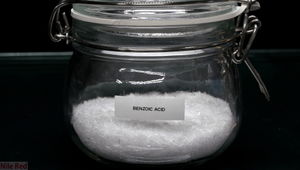Difference between revisions of "Benzoic acid"
| Line 87: | Line 87: | ||
| Solubility10 = 30 g/100 g (-18 °C)<br>32.1 g/100 g (-13 °C)<br>71.5 g/100 g (23 °C) | | Solubility10 = 30 g/100 g (-18 °C)<br>32.1 g/100 g (-13 °C)<br>71.5 g/100 g (23 °C) | ||
| Solvent10 = methanol | | Solvent10 = methanol | ||
| − | | Solubility11 =34 | + | | Solubility11 = 34.4 g/100 ml |
| Solvent11 = oil of turpentine | | Solvent11 = oil of turpentine | ||
| Solubility12 = 4.22 g/100 ml (25 °C) | | Solubility12 = 4.22 g/100 ml (25 °C) | ||
Revision as of 14:07, 4 April 2020
 Recrystallized benzoic acid
| |
| Names | |
|---|---|
| IUPAC name
Benzoic acid
| |
| Preferred IUPAC name
Benzoic acid | |
| Systematic IUPAC name
Benzenecarboxylic acid | |
| Other names
Carboxybenzene
Dracylic acid E210 Phenylmethanoic acid | |
| Properties | |
| C7H6O2 | |
| Molar mass | 122.12 g/mol |
| Appearance | White solid |
| Odor | Very faint benzaldehyde-like |
| Density | 1.2659 g/cm3 (15 °C) 1.0749 g/cm3 (130 °C) |
| Melting point | 122.41 °C (252.34 °F; 395.56 K) |
| Boiling point | 249.2 °C (480.6 °F; 522.3 K) (decomposes at 370 °C) |
| 1.7 g/L (0 °C) 2.7 g/L (18 °C) 3.44 g/L (25 °C) 5.51 g/L (40 °C) 21.45 g/L (75 °C) 56.31 g/L (100 °C) | |
| Solubility | Soluble in acetone, liq. ammonia, benzene, CCl4, chloroform, diethyl ether, ethanol, ethyl acetate, hexane, methanol, THF, toluene, xylene Slightly soluble in hexane, petroleum ether |
| Solubility in 1,4-Dioxane | 56 g/100 ml (25 °C) |
| Solubility in acetone | 69.1 g/100 g (20 °C) |
| Solubility in benzene | 10 g/100 ml |
| Solubility in carbon disulfide | 3.3 g/100 ml |
| Solubility in carbon tetrachloride | 4.0 g/100 ml |
| Vapor pressure | 0.16 Pa (25 °C) 0.19 kPa (100 °C) 22.6 kPa (200 °C) |
| Acidity (pKa) | 4.202 |
| Thermochemistry | |
| Std molar
entropy (S |
167.6 J·mol-1·K-1 |
| Std enthalpy of
formation (ΔfH |
-385.2 kJ/mol |
| Hazards | |
| Safety data sheet | Sigma-Aldrich |
| Flash point | 121.5 °C |
| Lethal dose or concentration (LD, LC): | |
| LD50 (Median dose)
|
1700 mg/kg (rat, oral) |
| Related compounds | |
| Related compounds
|
Sodium benzoate |
| Except where otherwise noted, data are given for materials in their standard state (at 25 °C [77 °F], 100 kPa). | |
| Infobox references | |
Benzoic acid, is a colorless crystalline solid and the simplest aromatic carboxylic acid.
It has the formula C7H6O2, though it's more conveniently written as C6H5COOH.
Contents
Properties
Chemical
Oxidative decarboxylation of benzoic acid between 300−400 °C gives phenol. If Cu(II) salts are used, the reaction can proceed at lower temperatures, around 200 °C:
- C6H5COOH + ½ O2 → C6H5OH + CO2
Decarboxylation of benzoic acid or its salts will yield benzene.
Physical
Benzoic acid is a colorless solid, poorly soluble in water, but more soluble in organic solvents.
Availability
Benzoic acid can sometimes be found in food stores as food preservative, though most of the time it's just plain old sodium benzoate, as the latter is more soluble in water.
Higher purity benzoic acid can be purchased from chemical suppliers or more convenient from eBay or Amazon.
Preparation
Benzoic acid can be prepared by oxidizing toluene with potassium permanganate.
- C6H5CH3 + KMnO4 → C6H5COOH + MnO2 + H2O
A more convenient and less smelly route involves the addition of an acid, such as diluted hydrochloric acid to sodium benzoate.
- C6H5COONa + HCl → C6H5COOH + NaCl
Benzoic acid, being less soluble than sodium benzoate, will precipitate out of the solution. The crude benzoic acid is then filtered and washed with cold water then dried.
Oxidation of benzaldehyde in air will give benzoic acid.
Projects
- Make benzene
- Make methyl benzoate
- Make ammonium benzoate
- Make copper(II) benzoate
Handling
Safety
Benzoic acid is practically non-toxic, though powdered form is irritant if inhaled.
Storage
Benzoic acid should be stored in closed bottles, away from alkali bases and ammonia.
Disposal
Benzoic acid doesn't require special disposal as it's harmless. Discard it as you wish.